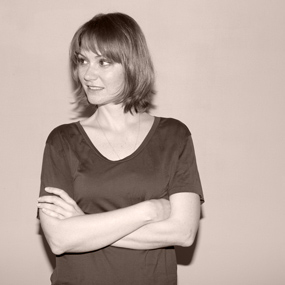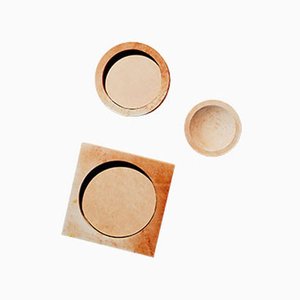Lou Weis crafts contemporary Australian design identity(s)
The Futurists—Part 5
In celebration of the 2017 edition of Salone del Mobile—as the international design community scans the horizon for what’s new this year—Pamono is offering up a five-part series on emerging voices that are articulating a more thought-provoking design future. For our fifth and final installment, we spotlight the researched and romantic work of Lou Weis, Creative Director of Broached Commissions.
**********
As co-founder and creative director of Melbourne-based design studio Broached Commissions, Lou Weis has played an integral role in defining contemporary Australian design—despite the fact that this one-of-a-kind philosopher-agent insists that Australian design “doesn’t really exist.” Together with entrepreneur Vincent Aiello and designers Trent Jansen, Adam Goodrum, and Charles Wilson, Weis launched Broached in 2011 on a mission to wrestle Australia’s multicultural heritage into original collections of expert-made, museum-quality design objects. Every series is intensely researched and themed around a thread of Australian history, like colonialism, Asian immigration, and native folklore. In fact, much of what Broached does aims to uncover and critically highlight aspects of the nations often-problematic social development. The designs produced by Broached are not merely conversation pieces; each one is a furniture-shaped dissertation on Australian identity.
Weis’s opposition to talking about “Australian design,” per se, stems from his intimate awareness of the diverse regional expressions found across the vast continent. He’s also well studied in the ebb and flow of stylistic influences from abroad that have mixed and mingled with local cultures, materials, and climates—all of which has resulted in a rather fluid national design narrative. Even so, this heterogeneity is, in his view, Australia’s strength; it has inspired him to focus Broached on mining this migration of aesthetics across time and place.
Broached Colonial was the studio’s first collection, comprising pieces that, in Weis’s words, “reflect upon the wildness, brutality, and resourcefulness of those initial decades of Australia’s history.” Weis invited Sydney-based curator and art historian John McPhee to give a private lecture on the political and social conditions of the early colonial period and then set the Broached designers off to respond. In addition to the core Broached designers (Jansen, Goodrum, and Wilson), the team invited Sydney’s Chen Lu and London’s Max Lamb and Lucy McRae to contribute works. “Every stage of the process [of creating Broached Colonial] was locked into place,” remembers Weis, “from the curator-specialist who guided the designers, to the excellence of the manufacturing. It took two years to deliver, and I only got to see all the pieces together when we did photography. That moment silenced me. For the first time my goal at the outset was matched by the outcome.” Since then, Broached has produced the Broached East collection, in collaboration with international designers like Naihan Li, Keiji Ashizawa, and Azuma Makoto, and has worked on a number of private and public interior commissions.
The latest from Broached is a collection designed by Jansen called Broached Monsters, which debuted in February at Criteria Collection in Melbourne. Exploring the wild, 18th-century European tales of terrifying Australian creatures, Monsters includes fur-covered chairs and bowls, a spiky glass chandelier, and an elaborately hand-wrought, “scaly” wood wardrobe and table. The forms are startling to be sure, but just as impressive is the unassailable skill and care that went into the production. They are, in a word, stunning.
“Design culture has returned to its mid-19th-century origins, when the Arts & Crafts movement first arose as a reaction to rampant industrialization,” say Weis. “Design is pushing for objects that are cherished rather than just 'used' until they break and are replaced. Design is trying to elevate the importance of boutique, urban manufacturing and craftsmanship over mass production.” Weis sees this as a widespread, global trend supported by consumers as well as creatives.
When asked to comment on the high price tag that frequently comes with such special design objects, he explains, “The reality is that making edition, small-batch, and [mass] retail production pieces are essentially three entirely separate processes. The edition pieces are crazy expensive for us to make, because they are about experimentation and detail-oriented craftsmanship. For the artisans, it isn’t even about the money; they make these works to have their capabilities and material knowledge put to the test.”
Never a snob, Weis places high-hopes on another design trend: that the worlds of design, eco-materials, and 3D printing will coalesce, supported by new, visionary entrepreneurs, so that what is discarded becomes biodegradable. “We need a disruption to the IKEA or MUJI paradigm by entrepreneurs with deep enough pockets to invest in highly sustainable, beautifully designed product lines. Moving us on from 'fast design,' which the world, from a material-use perspective, simply cannot sustain.”
With each Broached collection taking years to produce, Weis is happy with his contribution to the slow and local design movement. “My role will remain at the applied-arts, collectable end of the spectrum,” Weis concludes. “My goal as Creative Director of Broached is to commission as few works, as perfectly made, as possible—resulting in collections that appreciate over time. For my part, it requires enormous diligence and patience.” The results are well worth the wait, unlike anything you'll find anywhere else.
* Be sure to check out the other stories in our “Futurists” series, including profiles of Camp Design Gallery, curator Annalisa Rosso, design collective Form&Seek, and design “organizer” David Heldt of Connecting the Dots.
-
Text by
-
Wava Carpenter
After studying Design History, Wava has worn many hats in support of design culture: teaching design studies, curating exhibitions, overseeing commissions, organizing talks, writing articles—all of which informs her work now as Pamono’s Editor-in-Chief.
-


